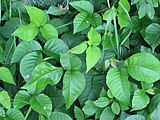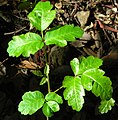m |
m (- Category of AYHAB) |
||
| (11 intermediate revisions by 3 users not shown) | |||
| Line 1: | Line 1: | ||
| − | <gallery> | + | <noinclude><translate><!--T:4--> |
| − | Image: | + | </noinclude> |
| − | Image: | + | |
| + | <!--T:5--> | ||
| + | <gallery perrow=2 widths=300px> | ||
| + | Image:Toxicodendron_radicans.jpg|<center>Poison Ivy</center> | ||
| + | Image:Poisonoakyoung.JPG|<center>Poison Oak</center> | ||
</gallery> | </gallery> | ||
| − | Poison ivy, poison oak, and poison sumac all cause a rash when oils from the plant come into contact with the skin. | + | <!--T:6--> |
| + | Poison ivy, poison oak, and poison sumac all cause a rash when oils from the plant come into contact with the skin. The contact does not have to be direct - it can be transferred from the plant to another item, and ''then'' to the skin. Tools, pets, and clothing can all transfer the oil from the plant to the skin. The best defense against this rash is to be able to recognize these plants, stay alert, and avoid contact. If you do come into contact with any of them, the first thing you should do is immediately wash the affected area with soap and water. This will, in many cases, prevent the rash from developing. If contact went undetected and a rash does develop, apply Calamine lotion or a cortizone cream to the affected area. If the rash develops on the face or genitals, seek medical attention. | ||
| + | <noinclude></translate></noinclude> | ||
Latest revision as of 22:56, 13 July 2022
Poison ivy, poison oak, and poison sumac all cause a rash when oils from the plant come into contact with the skin. The contact does not have to be direct - it can be transferred from the plant to another item, and then to the skin. Tools, pets, and clothing can all transfer the oil from the plant to the skin. The best defense against this rash is to be able to recognize these plants, stay alert, and avoid contact. If you do come into contact with any of them, the first thing you should do is immediately wash the affected area with soap and water. This will, in many cases, prevent the rash from developing. If contact went undetected and a rash does develop, apply Calamine lotion or a cortizone cream to the affected area. If the rash develops on the face or genitals, seek medical attention.


